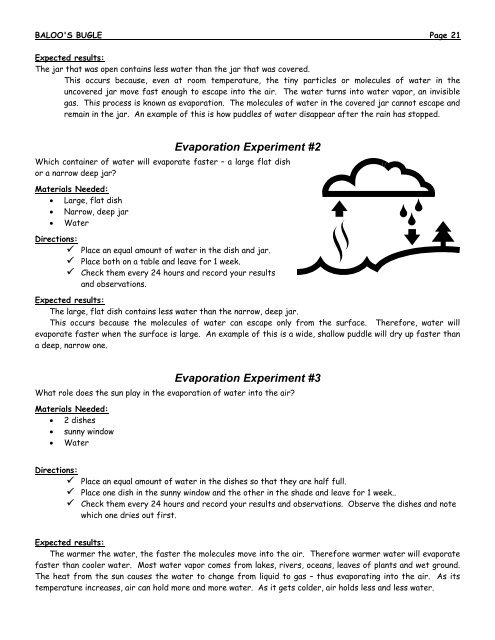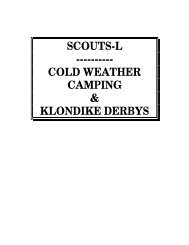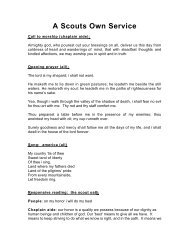BALOO'S BUGLE - US Scouting Service Project
BALOO'S BUGLE - US Scouting Service Project
BALOO'S BUGLE - US Scouting Service Project
You also want an ePaper? Increase the reach of your titles
YUMPU automatically turns print PDFs into web optimized ePapers that Google loves.
<strong>BALOO'S</strong> <strong>BUGLE</strong> Page 21Expected results:The jar that was open contains less water than the jar that was covered.This occurs because, even at room temperature, the tiny particles or molecules of water in theuncovered jar move fast enough to escape into the air. The water turns into water vapor, an invisiblegas. This process is known as evaporation. The molecules of water in the covered jar cannot escape andremain in the jar. An example of this is how puddles of water disappear after the rain has stopped.Evaporation Experiment #2Which container of water will evaporate faster – a large flat dishor a narrow deep jar?Materials Needed:• Large, flat dish• Narrow, deep jar• WaterDirections: Place an equal amount of water in the dish and jar. Place both on a table and leave for 1 week. Check them every 24 hours and record your resultsand observations.Expected results:The large, flat dish contains less water than the narrow, deep jar.This occurs because the molecules of water can escape only from the surface. Therefore, water willevaporate faster when the surface is large. An example of this is a wide, shallow puddle will dry up faster thana deep, narrow one.Evaporation Experiment #3What role does the sun play in the evaporation of water into the air?Materials Needed:• 2 dishes• sunny window• WaterDirections: Place an equal amount of water in the dishes so that they are half full. Place one dish in the sunny window and the other in the shade and leave for 1 week.. Check them every 24 hours and record your results and observations. Observe the dishes and notewhich one dries out first.Expected results:The warmer the water, the faster the molecules move into the air. Therefore warmer water will evaporatefaster than cooler water. Most water vapor comes from lakes, rivers, oceans, leaves of plants and wet ground.The heat from the sun causes the water to change from liquid to gas – thus evaporating into the air. As itstemperature increases, air can hold more and more water. As it gets colder, air holds less and less water.
















